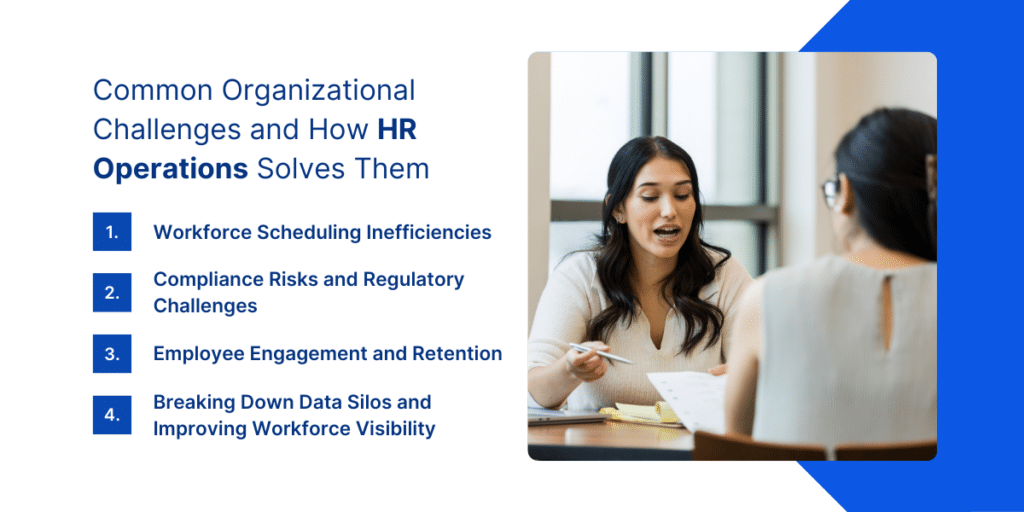According to a Gartner survey, only 9% of HR functions are both highly efficient and highly aligned with their organization’s needs. This gap highlights a widespread challenge: while companies invest in HR strategies and talent development, operational inefficiencies often hinder execution. Misalignment between HR processes and business objectives can lead to compliance risks, scheduling inefficiencies, and workforce dissatisfaction.
HR operations (HR Ops) play a critical role in keeping an organization’s workforce running smoothly. While many companies focus on HR strategy, talent acquisition, and employee development, HR Ops serve as the backbone that ensures policies and processes are executed efficiently. When aligned with broader organizational goals, businesses can optimize workforce planning, enhance compliance, and improve employee satisfaction.
What is Human Resource Operations?
HR operations (HR Ops) is the execution engine behind an efficient workforce, ensuring compliance, optimizing employee scheduling, and managing HR processes seamlessly.
An effective human resource operations team ensures that essential HR tasks are completed accurately and consistently. Key HR Ops roles and responsibilities include:
- Payroll and benefits administration
- Employee scheduling and shift management
- Compliance with labor laws and industry regulations
- Employee data management and reporting
- HR systems and technology management
Without a structured HR Ops approach, companies risk inefficiencies, compliance violations, and workforce dissatisfaction.
HR Management vs. HR Operations: Key Differences
Although HR management and HR operations work closely together, their functions differ significantly. Understanding these differences is crucial for optimizing HR processes and ensuring that both strategic initiatives and day-to-day execution align seamlessly.
HR Management: The Strategic Side of HR
HR management focuses on high-level decision-making, workforce planning, and employee development strategies. This function is essential for driving business goals through effective people management. Key areas of focus for HR management include:
- Talent Acquisition & Retention: HR managers develop hiring strategies, oversee recruitment efforts, and implement programs to improve employee retention.
- Employee Engagement & Culture Building: They foster a positive work environment by creating engagement programs, career development initiatives, and company-wide communication strategies.
- Performance Management: HR management designs and implements performance evaluation systems, ensuring that employees are recognized, developed, and promoted effectively.
- Policy Development & Implementation: While HR Ops enforces policies, HR management defines and refines them based on business needs and workforce trends.
- Workforce Planning & Organizational Growth: HR managers analyze talent gaps, succession planning, and future workforce needs to ensure the company can scale efficiently.
HR management is ultimately responsible for shaping the long-term vision of an organization’s workforce and ensuring that employees align with business objectives.
HR Operations: The Execution Engine
While HR management is focused on strategy, HR operations is responsible for executing policies, maintaining compliance, and managing administrative HR tasks that keep an organization running smoothly. The HR Ops function ensures that all workforce-related processes are efficient, consistent, and aligned with legal and company policies. Key responsibilities of HR Ops include:
- Payroll & Benefits Administration: Managing compensation structures, ensuring accurate payroll processing, and handling benefits enrollment.
- Workforce Scheduling & Shift Management: Optimizing labor allocation, tracking attendance, and reducing scheduling inefficiencies.
- Compliance & Risk Management: Ensuring adherence to labor laws, industry regulations, and internal HR policies to prevent legal risks.
- HR Systems & Technology Management: Implementing and maintaining HR software solutions, managing employee databases, and overseeing HR analytics.
- Employee Onboarding & Offboarding: Handling administrative tasks related to new hires and employee exits, ensuring compliance with company policies and regulatory requirements.
In essence, HR Ops transforms HR management’s strategic decisions into actionable processes. The operations manager’s responsibilities include overseeing these functions, ensuring accuracy, and continuously improving HR workflows.

Common Organizational Challenges and How to Solve Them
1. Workforce Scheduling Inefficiencies
Inefficient workforce scheduling results in labor shortages, excessive overtime costs, and compliance risks—all of which impact business performance. These inefficiencies can cause operational bottlenecks, increase labor costs, and negatively impact employee satisfaction due to unpredictable work schedules.
An optimized HR Ops strategy ensures balanced shift coverage, prevents scheduling conflicts, and maintains labor law compliance. By implementing scheduling automation, businesses can minimize manual errors, reduce administrative burdens, and ensure employees are assigned shifts that align with their availability and skills.
Additionally, HR Ops can facilitate better workforce forecasting by analyzing historical scheduling data, identifying peak demand periods, and optimizing shift rotations accordingly. This proactive approach reduces last-minute staffing shortages and prevents burnout from excessive overtime.
2. Compliance Risks and Regulatory Challenges
Compliance is a critical component of HR Ops. From wage laws and overtime rules to industry-specific regulations like FSMA and FMCSA, the HR Ops function ensures businesses remain compliant. Failure to comply with these regulations can lead to costly fines, legal disputes, and reputational damage.
Navigating HR compliance in the U.S. is complex due to varying federal, state, and industry-specific regulations. HR Ops ensures compliance by automating audits, tracking employee records, and preventing legal violations.
HR Ops teams play a crucial role in staying ahead of regulatory changes by continuously updating policies, ensuring accurate payroll reporting, and maintaining detailed records of employee work hours, certifications, and safety training. Implementing HR technology solutions can further enhance compliance efforts by flagging potential violations and ensuring timely documentation submissions.
3. Employee Engagement and Retention
HR operations impact employee satisfaction more than many organizations realize. If payroll errors occur frequently, benefits administration is inconsistent, or shift scheduling is mismanaged, employee morale suffers. Frustrated employees are more likely to disengage or seek employment elsewhere, leading to high turnover rates and increased hiring costs.
By streamlining HR processes and ensuring efficiency, HR Ops contributes to a positive employee experience, leading to higher retention and engagement. When employees receive timely and accurate paychecks, have access to well-structured benefits programs, and can rely on predictable scheduling, their trust in the organization strengthens.
HR Ops can also enhance engagement by implementing self-service HR portals where employees can check their schedules, request time off, and access benefits information. By empowering employees with greater control over their work arrangements, HR Ops fosters a culture of transparency and trust.
4. Breaking Down Data Silos and Improving Workforce Visibility
Data silos in HR create inefficiencies and hinder decision-making. When workforce data is fragmented across multiple systems—such as payroll software, scheduling tools, and performance management platforms—HR teams struggle to obtain a holistic view of the workforce. This lack of visibility makes it difficult to track trends, identify skill gaps, and make data-driven decisions.
Without a centralized workforce management system, HR Ops struggles to provide leadership with accurate, real-time workforce insights. This can result in misallocated resources, compliance oversights, and an inability to forecast workforce needs effectively.
By integrating HR technology, organizations can enhance workforce analytics, improve decision-making, and create a more agile workforce strategy. A unified HR system consolidates critical data points, allowing HR Ops to generate comprehensive reports, monitor key performance indicators (KPIs), and proactively address workforce challenges. With real-time access to labor data, businesses can quickly adjust staffing plans, optimize productivity, and ensure that workforce decisions align with organizational goals.

How Workforce Management Technology Optimizes HR Operations
HR operations teams handle a vast array of administrative and compliance-driven responsibilities, making efficiency and accuracy crucial. Without the right tools, HR Ops can become bogged down with manual processes, increasing the risk of errors, compliance violations, and operational inefficiencies. Workforce management technology provides a streamlined, data-driven approach that allows HR Ops to focus on strategic initiatives rather than administrative burdens.
To maximize efficiency and compliance, organizations must integrate HR Ops technology to automate workforce management and streamline HR workflows.
- Automation for Increased Efficiency: Workforce management solutions help automate HR tasks like scheduling, payroll processing, and compliance tracking. Automation reduces manual errors, saves time, and enhances accuracy.
- Real-Time Workforce Insights: A centralized HR system provides real-time data on employee attendance, shift coverage, and compliance metrics. This improves workforce planning and decision-making.
- Improved Compliance and Risk Mitigation: HR Ops technology helps organizations stay compliant by automating regulatory tracking, flagging potential violations, and ensuring accurate documentation.
By centralizing HR functions into a single system, organizations can enhance collaboration, improve response times to workforce challenges, and ensure HR operations align seamlessly with business objectives. Investing in the right technology not only optimizes HR workflows but also enhances employee experience, reduces costs, and strengthens overall workforce agility.
Strengthening HR Operations for Long-Term Success
HR operations alignment is essential for solving common organizational challenges, from workforce scheduling inefficiencies to compliance risks and employee engagement issues. Aligning HR Ops with workforce management technology enhances efficiency, reduces compliance risks, and builds a resilient, future-ready workforce.
Looking to optimize your human resource operations? Indeavor’s workforce management solutions help organizations streamline HR Ops, improve compliance, and enhance workforce planning. Learn more, or schedule a demo today.
About the Author
Claire Pieper is the Digital Marketing Specialist for Indeavor. In her role, she specializes in crafting strategic and engaging content, ensuring that customers are well-informed. Claire is dedicated to enhancing the customer experience and optimizing the user journey through Indeavor’s solutions. To learn more or get in touch, connect with Claire on LinkedIn.



